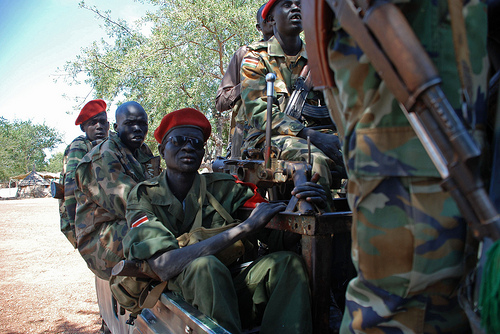
For months, the two Sudans have been facing off along their contested border. In September, they agreed to establish a buffer zone, 10 km north and south of the agreed upon center line, to separate their armed forces and reduce tension in the region. In the past week, both the governments of Sudan and South Sudan finally reported that their troops have withdrawn on their respective sides of the center line and will withdraw from the Safe Demilitarized Border Zone, or SDBZ.
South Sudan pledged on January 17 that its withdrawal south of the SDBZ would be complete by February 4, 2013. The following day, the Sudanese government pledged to withdraw its forces north of the SDBZ, but did not share its projected timeline. Although delayed, the recent and mutual commitment to withdraw forces is an important step towards ameliorating border violence and complying with their obligations under international agreements.
The border between the Sudan and South Sudan remains under dispute. In the past few months, the lack of an internationally monitored buffer zone has allowed continued violence and cross-border incursions to severely jeopardize civilian security. For example, November 2012 aerial attacks by Sudanese Armed Forces, or SAF, along the contested 14-mile border area in South Sudan’s Northern Bahr el Ghazal state resulted in 4,000 displaced people in Jaac.
It has been almost four months since September 27, 2012, when Sudan and South Sudan signed an agreement on security arrangements . According to that agreement, both countries’ armed forces were supposed to “immediately issue instructions to their forces to withdrawal unconditionally to their side of the border. […] Parties shall immediately operationalize […] the SDBZ.” While both countries agreed to a buffer zone in the September 2012 peace agreements, the ongoing conflict in Sudan’s periphery regions has allowed the government of Sudan to derail the process. Sudan demands that its fundamental security interests, namely the withdrawal of all South Sudanese forces from the disputed area and the disarmament of SPLM-N forces, are guaranteed before implementing negotiated security arrangements.
On Tuesday, Sudan's U.N. ambassador, Daffa-Alla Elhag Ali Osman, blamed South Sudan for the delayed implementation of the SDBZ, as Sudan has yet to receive confirmation that Juba has ceased alleged financial and technical support for SPLM–N rebels in Sudan’s territories, especially in the border states of Blue Nile and South Kordofan. Southern officials denied support for SPLM-N rebels and accused the government of Sudan of delaying implementation.
The South Sudan government claims its withdrawals are within the required implementation timeline agreed upon at the December 19, 2012 meeting of the Joint Political and Security Mechanism, or JPSM, co-chairs. The JPSM was established in December 2010 as a bilateral implementation mechanism and is comprised of representatives from the Sudanese and South Sudanese military, police, and government. Within 28 days of the December 19 agreement, its forces were below the center line; within 47 days of the agreement (February 4, 2013), its forces will be below the Safe Demilitarized Border Zone.
On Tuesday, the U.S. State Department criticized the governments for failing to comprehensively implement the September 2012 agreements. The United States advised the African Union and U.N. to demand that parties “urgently uphold” their commitments, such as the immediate withdrawal from the SDBZ, to advance regional peace and stability.
Photo: SPLA troops in Northern Bahr el Ghazal state (Enough / Laura Heaton)

